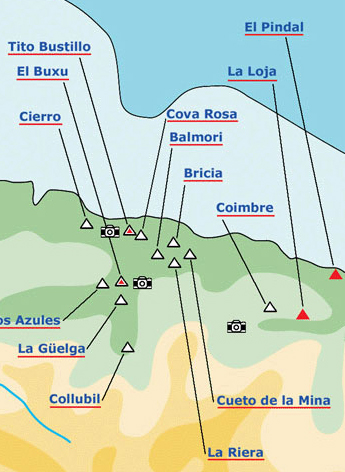Photo Archives: Paleolithic Art in Northern Spain
Tito Bustillo
Preview Edition
- 32 photos(about1280x1000/JPEG) and the 14 variations(about1470x980/JPEG).
- Commentary by César González Sainz & Roberto Cacho Toca, Univ. of Cantabria.
- Royality Free for private and educational use.
In this downloadable photo archives are contained 32 photos and the 12 variations of Paleolithic cave art of Tito Bustillo cave with the archeological data and commentary as shown in this preview pages. Only the small sized reference images and a part of commentary are shown in this preview edition, but if you are interested to see more and to use these photos, please go to Kagi store and purchase the data package. Once payment has been made at the Kagi store, you will receive an e-mail containing the URL to download the data package. All photos that are contained in this package are ROYALITY FREE for private and educational use.
 Tito Bustillo
Tito Bustillo
Cueva de Tito Bustillo is one of the five or six most important caves with Paleolithic art in the Cantabrian region, both because of the number of figures decorating its walls and for their stylistic and technical quality, and of course, for the esthetic quality of many of the figures.
The cave is located in the limestone hill of Ardines, a small hill overlooking the present-day estuary of the River Sella from its left bank. Nevertheless, during the Upper Paleolithic the coastline was further away, six or seven kilometers to the north at the time of maximum marine regression. At that time, Ardines hill controlled the natural route entering the inland Sella valley, as well as a wide, open coastal strip, which allowed easy communication between the different Cantabrian valleys, as it united them along a major East-West axis.
Ardines hill has well developed karst features, which helps to explain the large number of sites it contains with remains of Paleolithic occupation, and occasionally with cave art in the depths of the caves. This density of sites is comparable with Monte Castillo, La Garma, or other locations in the Cantabrian region that were frequently used in the Upper Paleolithic. In this way, Cueva de Tito Bustillo connects by a vertical chimney with Cueva de La Lloseta, which has its own Paleolithic habitat and a few paintings, and it must once have connected with the entrance of La Cuevona through a blocked passage at the eastern end of the "Long Gallery". The same hill has the caves of Viesca, Pedroses and El Cierro, and slightly further away, Cova Rosa. The right-hand bank of the estuary has Cueva de San Antonio, which also has an archaeological deposit, in this case a single Paleolithic painting of a horse.
The cave we now know as Cueva de Tito Bustillo is in fact a long passage several hundred meters long, reached today through an artificial tunnel. The two original entrances are blocked by collapses of large boulders and other material. A narrower section, which forms an obstacle part way along the "Long Gallery", and certain differences in the parietal art along the passage, have meant that two large sectors are differentiated in Tito Bustillo: the eastern and the western. Each sector had its own entrance in the Upper Paleolithic, and have an archaeological deposit.
---------
[References]
Balbin, R, 1989. L'art de la grotte de Tito Bustillo (Ribadesella, Espagne). Une vision de synthese. L'Anthropologie 93/2, pp. 435-462.
Balbin, R; Moure, J.A., 1982. El panel principal de la cueva de Tito Bustillo (Ribadesella, Asturias). Ars Praehistorica I, pp. 47-97.
|
Photographed by Takeo Fukazawa & Co-Project Team of Texnai Inc. and the University of Cantabria
Comment by César González Sainz & Roberto Cacho Toca, Univ. of Cantabria
Texnai Inc.:
2-1, Udagawa-cho, Shibuya-ku, Tokyo, Japan. Tel:03-3464-6927 Fax:03-3476-2372
e-mail:info@texnai.co.jp
Copyright reserved by Takeo Fukazawa &Texnai, Inc., University of Cantabria, IPA
|
|